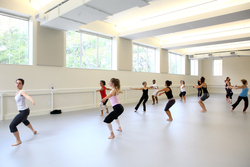
Modern dance students in the new and improved Studio A
By Sandra Record
Editor, TCU This Week
January 2011 began a semester and a summer of relocation and aggravation for faculty, staff and students in the School for Classical & Contemporary Dance. That same period was a long season of noise and dust for main campus neighbors around the Ballet Building.The structure, one of the oldest on campus, was getting a much-needed overhaul.
Recently named Erma Lowe Hall, honoring the late mother of major donor Mary Ralph Lowe, the building is just about ready for its public debut. Visitors will be amazed at the transformation because very little about the floor plan remains the same.
Although there is still access through the original doorways facing S. University Drive, the main entrance is now on the west side, adjoining the visitors parking lot. The interior was entirely gutted, taken down to the outside walls and original support columns inside. Architects Gideon Toal envisioned a somewhat industrial “New York loft” look for the new spaces housing studios, offices, workrooms and lounge areas.
That explains the open ceilings, exposed ductwork and columns, and interior concrete and brick. But, oh, the amenities that dance faculty and students never had before!
- Elevator
- Water fountains on every floor
- Wall insulation
- Utility closet and sink for housekeepers
- Spacious tiled locker rooms for students with multiple showers and sinks
- A lounge area with adjacent kitchen facilities
- 26-station computer lab
- LCD screens throughout the building
- Public restrooms for guests attending performances
- Well-equipped prop room and costume shop
The list goes on and on, a catalog of basic amenities along with the 21st century high-tech gizmos and gadgets that newer campus buildings have enjoyed for years. It’s taken a while to accomplish all this because the Ballet Building was built in 1921 as the University’s gymnasium, presenting formidable architectural challenges to renovation. According to Joan Hewatt Swaim’s book on campus history, Walking TCU, the “little gym” housed all physical education activity until 1973 when the original Rickel Building opened.
In addition to the P.E. curriculum, TCU’s athletic programs were directed from there until Daniel-Meyer Coliseum went up in the 1960s. What is now a conference room in Erma Lowe Hall was once office space for legendary football coach Dutch Meyer during the 1930s-1940s heyday of the “Fightin’ Frogs.”
TCU’s Ballet program, created by David Preston in 1949, moved into the building in 1973, flooring over a full-sized swimming pool in the basement and transforming basketball and handball courts into dance studios.
Ellen Shelton, director of the SCCD, notes that during the recent “bare bones” renovation project the old swimming pool was revealed, appearing rather “pristine” and still bearing the meter demarcations from long ago swim meets.
Ellen commends Beck Construction for their tireless work during this compressed time frame for getting the building up and running. "I learned a lot about construction during this process," Ellen says with a laugh. ""But they learned a lot about the arts."
The School plans to host an open house for all the workers and their families once things settle down. Meanwhile, the TCU campus community will have its opportunity to see what’s happening inside when dancers present a free lunchtime recital at noon Monday, Oct. 17 in the Studio B Theatre of the “new” Erma Lowe Hall.
